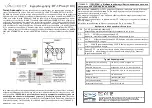
16-14
MPC860 PowerQUICC UserÕs Manual
MOTOROLA
Part IV. Hardware Interface
Table 16-6 describes bits for MAMR/MBMR.
Bit
0
1
2
3
4
5
6
7
8
9
10
11
12
13
14
15
Field
PT
x
PT
x
E
AM
x
Ñ
DS
x
Ñ
Reset
0000_0000_0000_0000
R/W
R/W
Addr
(IMMR & FFFF0000) + 0x170
Bit
16
17
18
19
20
21
22
23
24
25
26
27
28
29
30
31
Field
G0CL
x
GPL
x
4DIS
RLF
x
WLF
x
TLF
x
Reset
000
1
0000
0000
0000
R/W
R/W
Addr
(IMMR & FFFF0000) + 0x172
Figure 16-10. Machine A Mode Register/Machine B Mode Registers (MxMR)
Table 16-6. MxMR Field Descriptions
Bits
Name Description
0Ð7
PT
x
Periodic timer
x
period. Affects periodic timer
x
and determines the timer period service rate
according to the following equation, which determines value for UPM
x
to refresh memory:
NCS is an integer between 1 and 8 that represents the number of enabled chip selects that are
serviced by this UPM. SCCR[DFBRG] is deÞned in Section 15.6.1, ÒSystem Clock and Reset
Control Register.Ó For example, for DRAM to maintain data integrity, an access or refresh must
occur every 15.6
m
s. Given a 25-MHz system clock with the required service rate of 15.6
m
s, a
periodic timer prescaler = 32, and DFBRG = 0, PT
x
= (25
´
15.6) / (2
2
´
0
´
32
´
1) = 12.
8
PT
x
E
Periodic timer
x
enable. Allows the periodic timer
x
to request service.
0 Periodic timer
x
is disabled.
1 Periodic timer
x
is enabled.
9Ð11
AM
x
Address multiplex size
x
. When internal address multiplexing is used, this Þeld speciÞes how the
address on the external bus is multiplexed, when enabled (see Table 16-17). The SAM bit
enables address multiplexing in the Þrst clock cycle. The AM
x
Þeld of the RAM array entry
enables address multiplexing in subsequent clock cycles. (see Table 16-18).
12
Ñ
Reserved, should be cleared.
13Ð14 DS
x
Disable timer period. Guarantees a minimum time between accesses to the same memory bank
if it is controlled by the UPM
x
. This function can be used to guarantee a minimum RAS
precharge time. The TODT bit in the RAM array turns on the disable timer and, when expired,
the UPM
x
allows the machine access to issue a memory pattern to the same region. An access
attempted before the timer expires (as signalled by TS assertion) has wait states inserted before
the UPM pattern runs. Accesses to other chip-selects serviced by this UPM are unaffected by
this timer. The maximum disable period is four clock cycles. If more than 4 cycles are required,
they must be added explicitly in the UPM RAM words.
00 1-cycle disable period
01 2-cycle disable period
10 3-cycle disable period
11 4-cycle disable period
15
Ñ
Reserved, should be cleared.
PTx
System Clock (MHz)
Service Duration (
m
s)
´
2
2
SCCR DFBRG
[
]
´
Prescaler (PTP)
´
NCS
´
---------------------------------------------------------------------------------------------------------------------
=
Summary of Contents for MPC860 PowerQUICC
Page 3: ...MPC860UM AD 07 98 REV 1 MPC860 PowerQUICC ª UserÕs Manual ...
Page 36: ...xxxvi MPC860 PowerQUICC UserÕs Manual MOTOROLA CONTENTS Paragraph Number Title Page Number ...
Page 78: ...I iv MPC860 PowerQUICC UserÕs Manual MOTOROLA Part I Overview ...
Page 88: ...1 10 MPC860 PowerQUICC UserÕs Manual MOTOROLA Part I Overview ...
Page 114: ...3 16 MPC860 PowerQUICC UserÕs Manual MOTOROLA Part I Overview ...
Page 226: ...8 32 MPC860 PowerQUICC UserÕs Manual MOTOROLA Part II PowerPC Microprocessor Module ...
Page 262: ...9 36 MPC860 PowerQUICC UserÕs Manual MOTOROLA Part II PowerPC Microprocessor Module ...
Page 274: ...III iv MPC860 PowerQUICC UserÕs Manual MOTOROLA Part III Configuration ...
Page 320: ...12 12 MPC860 PowerQUICC UserÕs Manual MOTOROLA Part III Configuration ...
Page 325: ...MOTOROLA Part IV Hardware Interface IV v Part IV Hardware Interface ...
Page 326: ...IV vi MPC860 PowerQUICC UserÕs Manual MOTOROLA Part IV Hardware Interface ...
Page 352: ...13 26 MPC860 PowerQUICC UserÕs Manual MOTOROLA Part IV Hardware Interface ...
Page 394: ...14 42 MPC860 PowerQUICC UserÕs Manual MOTOROLA Part IV Hardware Interface ...
Page 426: ...15 32 MPC860 PowerQUICC UserÕs Manual MOTOROLA Part IV Hardware Interface ...
Page 530: ...17 26 MPC860 PowerQUICC UserÕs Manual MOTOROLA Part IV Hardware Interface ...
Page 632: ...21 44 MPC860 PowerQUICC UserÕs Manual MOTOROLA Part V The Communications Processor Module ...
Page 660: ...22 28 MPC860 PowerQUICC UserÕs Manual MOTOROLA Part V The Communications Processor Module ...
Page 708: ...24 24 MPC860 PowerQUICC UserÕs Manual MOTOROLA Part V The Communications Processor Module ...
Page 748: ...27 20 MPC860 PowerQUICC UserÕs Manual MOTOROLA Part V The Communications Processor Module ...
Page 846: ...31 20 MPC860 PowerQUICC UserÕs Manual MOTOROLA Part V The Communications Processor Module ...
Page 914: ...35 12 MPC860 PowerQUICC UserÕs Manual MOTOROLA Part V The Communications Processor Module ...
Page 948: ...36 34 MPC860 PowerQUICC UserÕs Manual MOTOROLA Part V The Communications Processor Module ...
Page 998: ...37 48 MPC860 PowerQUICC UserÕs Manual MOTOROLA Part VI Debug and Test ...
Page 1016: ...A 10 MPC860 PowerQUICC UserÕs Manual MOTOROLA Appendixes ...
Page 1024: ...B 8 MPC860 PowerQUICC UserÕs Manual MOTOROLA Appendixes ...
Page 1030: ...C 6 MPC860 PowerQUICC UserÕs Manual MOTOROLA Appendixes ...
Page 1086: ...Glossary 12 MPC860 PowerQUICC UserÕs Manual MOTOROLA ...
Page 1106: ......















































